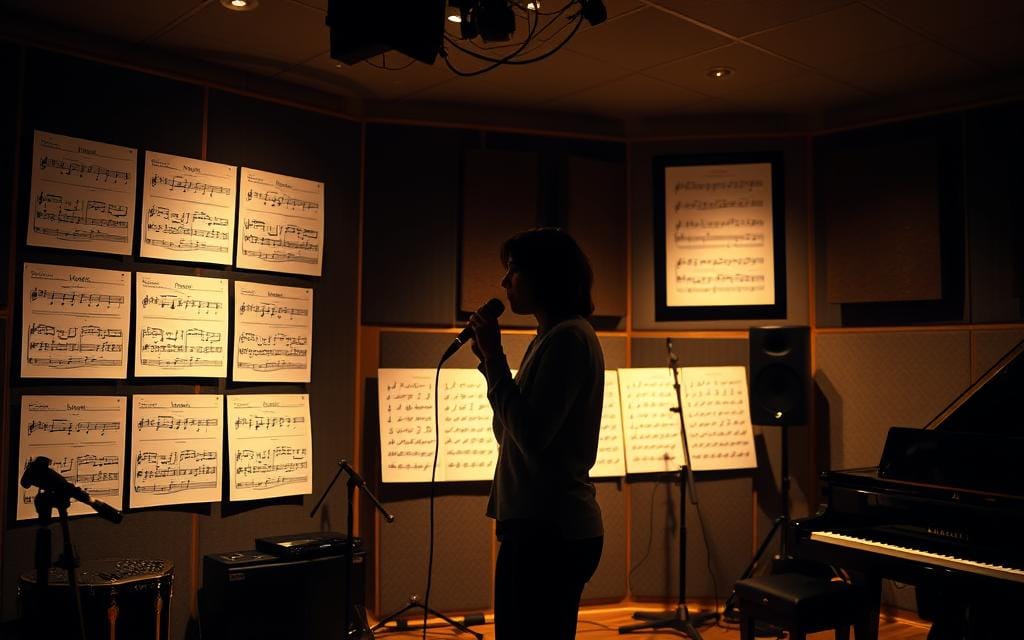Singing in Different Genres: Adapting techniques for various musical styles
Have you ever wondered how some singers can easily move between genres? It’s not just about talent. It’s about knowing how to change your singing style for each music type.
In today’s music world, being able to sing in many styles can be important. Singers who can do this have more chances to create and grow in their careers. Whether you’re singing opera one night and pop songs the next, your skill in switching styles shows your range.
Every music style has its own rules and what people expect. Blues music needs real emotion and a certain sound. Musical theater asks for clear words and big feelings.
Your voice is special and can change in many ways. By trying out different singing styles, you can find new sounds and find your true self.
This guide will give you tips on how to move between genres without losing your unique voice. You’ll learn skills that work in many genres and special tips for different kinds of songs.
Understanding Vocal Fundamentals Across Genres

Every singer needs a solid base of vocal skills, no matter the music style. Whether you want to sing opera, rock, jazz, or country, the basics of singing are the same. Knowing these basics helps you adjust your voice for different styles while keeping it healthy.
Think of your voice as a house; you need a strong foundation before you can build it. Many singers skip the basics and jump into specific styles, which can hurt their voice.
The Core Elements of Healthy Singing
Proper breath support is important for all singing; without it, your voice lacks power and control.
Vocal projection comes from good breath support, resonance, and vowel sounds. Instead of pushing your voice, focus on making space in your throat and letting sound resonate in your face.
How Vocal Technique Varies Between Styles
Even though the basics are the same, how you use them changes with each genre. Classical singers focus on steady vibrato, clear vowels, and formal speech. They work on their head voice and project without a mic.
Pop singers use different tones, speech-like delivery, and sometimes vibrato. They often focus on feeling the song. Their breathing might not be as obvious, but it’s just as important.
Rockers use their chest voice and sometimes add distortion or rasp. The raw sound of rock actually requires a lot of technique to keep up.
Jazz singers need to be very accurate with pitch and rhythm. Their breathing supports long notes and quick phrases. Jazz’s improvisational nature requires a strong technical base for creativity.
Instead of changing everything for each genre, make smart adjustments while keeping the basics strong.
Knowing these differences helps you avoid harmful techniques when trying new styles. With the right guidance, you can change your voice for different styles.
Why Vocal Versatility Matters More Than Ever

Artistic Growth and Discovery
Sticking to one genre is like only ever using one color to paint. Each musical style teaches you something new about your instrument. Classical training can instill incredible breath control that will improve your rock singing.
The rhythmic precision of hip-hop can tighten your phrasing in pop. Exploring genres pushes you out of your comfort zone, forcing you to grow and preventing artistic stagnation.
Building a Wider Audience
When you can sing in different genres, you can connect with a broader fanbase. A listener who discovers you through a folk song might stay for your R&B cover, introducing your music to a whole new network of people.
Showcasing this range on social media platforms like TikTok and Instagram is a powerful way to engage a diverse audience and demonstrate your skill.
Developing a Unique Signature Sound
Paradoxically, exploring other genres is the best way to find your own voice. By studying the greats across music history, you absorb a wealth of techniques and ideas. You then get to choose which elements resonate with you, blending them to create a sound that is distinctly yours.
Artists like Freddie Mercury, Beyoncé, and Chris Stapleton are all masters of this synthesis, weaving classical, gospel, R&B, and country into their iconic styles.
The Universal Foundation: Singing Techniques for Every Genre

Before you can successfully run, you must learn to walk. The same is true for singing in different musical genres. No matter the style—be it opera, metal, or jazz—every healthy vocal technique is built upon the same non-negotiable foundation. Ignoring these basics in favor of stylistic flair is a surefire way to cause strain and potential damage.
Breath Support: The Engine of Your Voice
Breath is the fuel for singing. Without proper support, your voice will lack power, control, and stamina. The goal is diaphragmatic breathing, which means engaging the large, dome-shaped muscle at the base of your lungs to control the flow of air.
How to Feel It
Place one hand on your chest and the other on your stomach. Take a slow, deep breath in through your nose. You should feel the hand on your stomach move outward, while the hand on your chest remains relatively still. As you exhale on a gentle “sss” sound, feel your stomach slowly pull back in. This controlled exhale is the sensation of supported breath.
Why It’s Universal
Whether you’re singing a delicate folk melody or a roaring metal riff, you need a steady stream of air. The style will dictate how you use that air, but the support system remains the same.
Posture and Alignment: The Framework for Sound
Your body is the resonator for your voice. Poor posture collapses your lungs and creates tension in your neck and jaw, stifling your sound and leading to fatigue.
The Ideal Singing Posture
Stand with your feet shoulder-width apart, knees slightly bent and unlocked. Imagine a string pulling the crown of your head toward the ceiling, lengthening your spine. Keep your shoulders relaxed and down, and your chest comfortably lifted. This open stance allows for maximum lung capacity and efficient breath flow.
Vocal Health and Hygiene: Protecting Your Instrument
Your vocal cords are delicate muscles. Exploring new genres can be demanding, so taking care of them is paramount.
Hydration: Drink plenty of water throughout the day. Your vocal cords need to be well-lubricated to vibrate efficiently.
Vocal Rest: If your voice feels tired, hoarse, or scratchy, rest it. Pushing through fatigue is a primary cause of injury.
Warm-Ups and Cool-Downs: Never skip them. Gently prepare your voice for the work ahead with scales and lip trills, and cool down afterward with gentle humming to relieve tension.
A Genre-by-Genre Breakdown: Vocal Techniques and Tips

Now, let’s apply that solid foundation to the art of singing in different genres. Here’s how the core principles adapt to the unique demands of each style.
1. Classical and Opera
Classical singing is the ultimate training ground for vocal control and power. The goal is to create a rich, resonant, and volumous sound that can project over an orchestra without a microphone.
Key Techniques: A high, stable soft palate and a low larynx create the characteristic “rounded” and open sound. Vibrato (a gentle, rhythmic oscillation in pitch) is used consistently. Diction is precise and often requires learning IPA (International Phonetic Alphabet) for foreign languages.
Breath Application: Breath support is paramount, used to create long, seamless vocal lines (legato) and sustain phrases for what seems like an impossibly long time.
Mindset: Think of filling a large hall with sound. The focus is on beauty, power, and technical precision.
2. Pop, Rock, and Contemporary Music
This broad category prioritizes expression, authenticity, and connection over classical perfection. The microphone is your best friend, allowing for intimacy and a wide range of effects.
Key Techniques: Belting (singing high notes with powerful chest voice) is a cornerstone. Singers also use breathy tones, vocal fry, and speech-like delivery to create a conversational feel. Rhythmic precision and catchy phrasing are essential.
Breath Application: Breath support is just as crucial, but used differently. It provides the power for belting without screaming and the control for soft, breathy passages.
Mic Technique: Learning to work with a microphone is a skill in itself. Sing closer for quiet, intimate moments and pull back for powerful notes to avoid distortion.
3. Jazz and Blues
Jazz singing is the art of improvisation and personal interpretation. It’s about making a standard song your own through rhythmic play, melodic embellishment, and soulful expression.
Key Techniques: Scat singing (improvising with nonsense syllables), melodic paraphrasing, and rhythmic displacement (playing with the timing of phrases) are key skills. A relaxed, conversational tone is common, often with a smoky or slightly dark color.
Breath Application: Breath support allows for the long, languid phrases of a blues ballad and the quick, agile runs of an uptempo bebop tune.
Mindset: Listen to the band! Jazz is a conversation. Your voice is another instrument in the ensemble, responding to and playing off the rhythm section.
4. Musical Theater
MT singing is acting through song. The story and character are always the top priority. This genre often requires the most drastic stylistic shifts, sometimes within a single show.
Key Techniques: Clarity of diction is non-negotiable—every word of the story must be heard. Performers must blend legit (classical) singing with more contemporary belt and mix singing. Emotional authenticity drives the technical choices.
Breath Application: Breath is used to support both powerful belt notes and sustained, lyrical passages, all while maintaining the physicality of acting on stage.
Mindset: You are not just a singer; you are a storyteller. Your technique serves the character’s emotional journey.
5. Country and Folk
At its heart, this genre is about authenticity, storytelling, and a raw, emotional connection. The voice often carries a distinctive twang and a straightforward, honest quality.
Key Techniques: The use of “cry” or “twang” (achieved by narrowing the aryepiglottic sphincter) gives the voice its characteristic bright, piercing quality. Slides, scoops, and a conversational tone make the delivery feel personal and unguarded.
Breath Application: Support is used to give power to the storytelling without making it sound overly polished or operatic. It’s about controlled authenticity.
Mindset: Imagine you’re singing directly to one person, telling them a deeply personal story. The goal is to make it feel real, not perfect.
Practical Exercises for Building Versatility

Theories are useless without practice. Here are concrete exercises to help you start singing in different genres safely.
1. The Style Switch-Up:
Take a simple, familiar melody like “Happy Birthday” or “Amazing Grace.” Now, sing it in three different styles:
A classical piece with rounded vowels, vibrato, and operatic flair.
A pop song, with a speech-like tone, catchy rhythms, and a few riffs.
A jazz standard, swinging the rhythm, sliding into notes, and improvising a simple ending.
This exercise trains your brain and voice to make quick technical adjustments.
2. Genre Immersion Listening:
Pick a genre you’re less familiar with. Find five iconic artists from that genre and listen actively. Don’t just hear it; analyze it.
Where do they take breaths? What does their tone sound like? How do they phrase their words? Try to mimic one of their songs, not to copy them, but to understand the mechanics of the style.
3. The Dynamic Microphone Drill:
Practice singing a song with a microphone (even a showerhead will do!). consciously:
Sing two inches from the mic for a verse to create intimacy.
Pull back to a foot away for a chorus to project more.
Experiment with how turning your head away from the mic on a loud note can prevent distortion. This builds essential skills for contemporary genres.
Navigating the Challenges: Vocal Health and Identity

As you explore, be mindful of two big challenges: strain and identity.
Avoiding Vocal Strain: Jumping into a new genre can be taxing. If you feel any pain, tension, or hoarseness, stop immediately. The goal is to adapt your technique, not to force your voice into an unhealthy place.
Belting, distortion, and growling can all be done safely with proper breath support and by using structures like the false vocal folds.
If you’re serious, working with a vocal coach who understands multiple genres is the best investment you can make.
Finding Your Authentic Voice: The end goal of singing in different genres isn’t to become a master impersonator. It’s to expand your palette so you have more colors to paint with.
Your unique artistic voice comes from the choices you make—which elements of country, which shades of jazz, which power of rock you choose to blend into your own personal style.
Don’t get lost in imitation; use exploration to fuel your originality.
Singing in different genres - Your Journey Awaits
Singing in different genres is a lifelong journey that keeps the art of singing fresh, exciting, and deeply rewarding.
It is a pursuit that builds not only technical skill but also musical intelligence, empathy, and artistic confidence.
By committing to this path, you are choosing to become a more complete, adaptable, and insightful musician.
So, take this guide, start with the fundamentals, and then bravely step into a new genre this week.
Be patient with yourself, listen to your body, and most importantly, have fun discovering the incredible potential that has been within your voice all along.
The world of music is vast and diverse—and now, you have the tools to sing your way through all of it.
Improve your Singing in 30 Days

Join Our Singing Community
Become a part of the Singing Community and gain access to exclusive resources and expert guidance on vocal techniques. Whether you’re a beginner or a seasoned performer, our community offers support and inspiration to help you reach your vocal potential.

